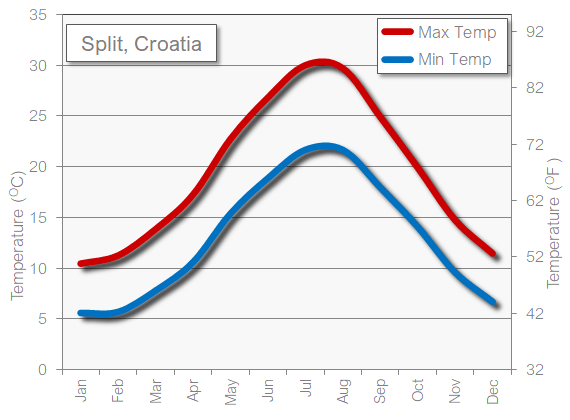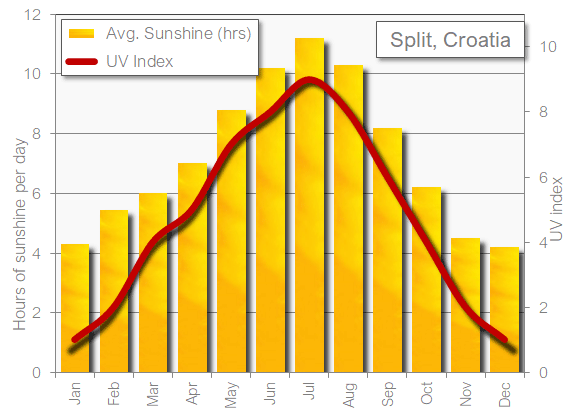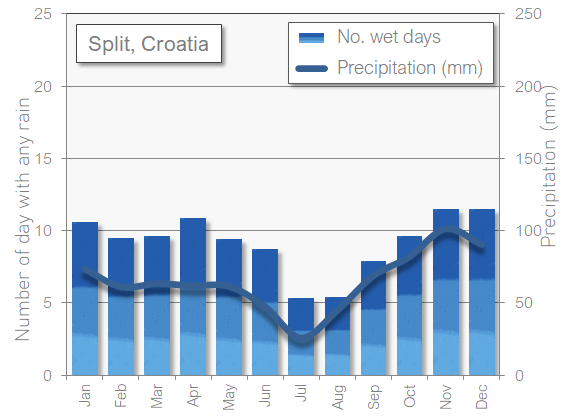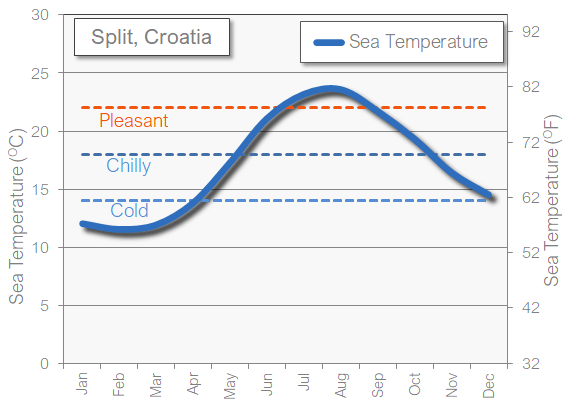Split, Croatia in January - The weather and is it a good time of year to visit?
Split, Croatia's second-largest city, is a captivating blend of ancient history and modern vibrancy. This coastal gem on the Dalmatian coast boasts over 1,700 years of rich cultural heritage, with its heart centred around the UNESCO World Heritage site of Diocletian's Palace. As you wander through the winding streets, you'll encounter a living museum where Roman ruins seamlessly intertwine with bustling cafes, shops, and residences.
January might not be the typical time to visit Split, but it offers a unique perspective on this Mediterranean jewel. While the weather is cooler and some tourist attractions may have reduced hours, you'll experience the city's authentic winter charm. The absence of summer crowds allows for a more intimate exploration of Split's treasures, and you might find yourself sharing the streets mainly with locals, providing a genuine insight into daily life in this historic city.
Overview of Split's Climate in January
January in Split showcases the city's Mediterranean climate at its coolest. While milder than many European destinations, it's decidedly wintry by local standards. The month typically brings cooler temperatures, increased chances of rainfall, and occasional strong winds. Despite this, Split's winter is relatively mild compared to inland Croatia, with frost and snow being rare occurrences.

January temperatures in Split are cool but generally mild compared to many other European cities. During the day, you can expect average high temperatures to hover around 11°C (52°F). These daytime temperatures can feel quite pleasant, especially on sunny days, allowing for comfortable outdoor exploration if you're properly dressed.
Nighttime brings a noticeable chill, with average low temperatures dipping to about 5°C (41°F). While these temperatures rarely plummet below freezing, the combination of cool air and potential wind can make evenings feel quite brisk. It's worth noting that these are average temperatures, and actual conditions can vary. Some days might see highs reaching 13°C (55°F) or even 15°C (59°F), while others might struggle to climb above 8°C (46°F), especially during cloudy or rainy periods.

January in Split offers limited but gradually increasing daylight hours. At the start of the month, you can expect about 9 hours of daylight, which increases to around 10 hours by the end's end. This gradual lengthening of days becomes more noticeable as the month progresses, providing slightly more time for outdoor activities and sightseeing.
Despite the shorter days, Split still enjoys a fair amount of sunshine in January, with an average of 4 to 5 hours of sunshine per day. While this is considerably less than the summer months, it's still enough to brighten many winter days. You can expect a mix of sunny and cloudy days, with clear skies often following periods of rain. The quality of light during sunny winter days can be particularly crisp and clear, offering beautiful views of the city and surrounding landscapes.

January is one of the wetter months in Split, with an average rainfall of around 80mm spread over about 11 rainy days throughout the month. These rainy days typically bring light to moderate showers rather than persistent, heavy downpours. However, occasional storms can occur, bringing heavier rain and strong winds.
The likelihood of rain is fairly consistent throughout the month, so it's wise to be prepared for wet weather at any time during your visit. Despite the increased rainfall, humidity levels are generally moderate, averaging around 60-70%. This means that even on rainy days, the air doesn't feel oppressively damp or muggy.

While Split's beaches are quiet in January, the Adriatic Sea remains a prominent feature of the city's landscape. The average sea temperature in January is around 14°C (57°F). This is considerably cooler than the summer months and too cold for comfortable swimming for most people.
Despite the chilly temperatures, you might still see some hardy locals taking a quick dip, particularly on sunny days. However, for most visitors, water activities are limited to admiring the sea views or taking brisk walks along the shore. If you're interested in water sports, specialised cold-water gear would be necessary for any extended time in the water.
Clothes to pack for January in Split
When packing for Split in January, it's best to prepare for cooler, wetter weather. Layering is essential - bring long-sleeve shirts, sweaters, and a sturdy, waterproof jacket for those frequent showers. A good pair of water-resistant shoes is also recommended, given the city's cobbled streets can become slippery when wet. And while the days might call for warmer clothes, the cooler nights demand a thicker jacket or coat.
The best months to visit Split
Visiting Split during May, June, and September offers the most pleasant experiences. May greets visitors with blooming flora and comfortable temperatures, without the summer rush. June ushers in the sun-soaked days ideal for beach lounging and water activities. September, while bidding goodbye to summer, retains much of the warmth but without the peak season's tourist crowds, allowing a more laid-back exploration.
Least Desirable Time to Visit Split
July and August, while undoubtedly sunny and vibrant, can sometimes be overwhelmingly crowded. These months mark the peak tourist season when the city is bustling, prices surge, and the temperature can reach the high 30s (around 100F). For those seeking tranquillity and a leisurely pace, these might not be the most ideal months to visit.
Fantastic activities for Split during January
Explore Diocletian's Palace: This ancient Roman palace is a living monument and the heart of the city. In January, with fewer crowds, you can take your time to explore its many hidden corners, soak in its history, and imagine life here in ancient times.
Visit the Museum of Split: This cultural institution is home to a rich collection of artifacts, providing insight into the region's past. January's cooler weather is ideal for spending time indoors, discovering the city's rich heritage.
Stroll the Marjan Hill: Offering panoramic views of Split and the Adriatic, Marjan Hill is perfect for nature lovers. The cooler January weather is ideal for exploring its dense pine forests and hidden ancient chapels.
Experience Croatian Cuisine: Split's eateries offer hearty dishes that are perfect for January's chill. Restaurants like Konoba Hvaranin offer traditional delicacies such as 'Pasticada', a delicious stewed beef dish, which is a must-try.
Take a Day Trip to Krka National Park: Even in winter, this nature park is breathtaking. The park is less crowded in January, making it the perfect time to witness the beautiful waterfalls and abundant wildlife.
Visit Salona's Ruins: Just a short drive from Split, you'll find the ruins of Salona, once a bustling Roman city. It's an excellent day trip for history buffs and explorers alike.
Explore Split’s Art Galleries: Galleries such as Galerija Mestrovic house an impressive collection of masterpieces, a perfect indoor activity for January's cooler days.
Discover Split’s Wine Scene: Enjoy an indoor wine tasting experience at Putalj Winery or similar locales, sampling Croatia's delightful wines and learning about its rich winemaking history.
Stroll the Riva Promenade: Although the sea might be too cold for a swim, the seafront promenade is always ready for a leisurely stroll, hot coffee in hand, soaking in the winter ambiance.